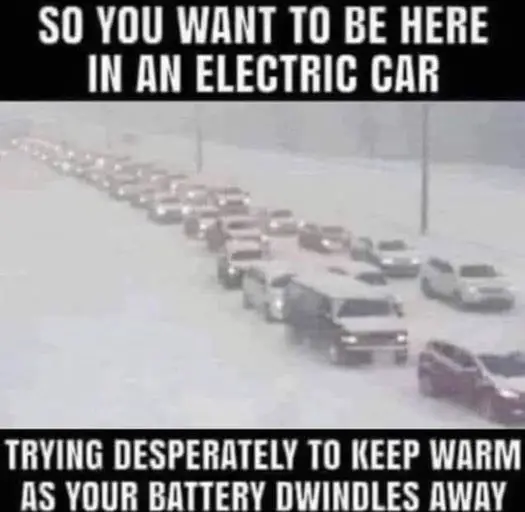Contrary to popular belief, you can keep your heater on in an electric car, often for more than a day and still have plenty of charge left to spare to drive off.
A slam dunk on electric cars I typically see posted is this meme, which implies you’ll freeze to death if you’re stuck in the middle of a traffic jam trying to drive out of some city in the middle of winter.

It assumes you can idle in a gas car, keeping the engine running with the heater on, staying toasty warm for far longer than you can in an electric car.
Is there some truth to that?
Kind of.
Here’s why you can probably survive in a cold, electric car stuck in traffic in the middle of a winter apocalypse just as well as a car that runs on gas, with a handful of exceptions to keep in mind.
First, it’s important to understand that electric cars don’t have the same type of heater as a gas car.
Whereas a gas car extracts heat from the engine via hot coolant, most modern electric cars today use a heat pump which extracts heat from the outside air, a lot like an air conditioner in reverse.
While heat pumps are efficient, even in cold temperatures, they do use a lot of battery.
To figure out how long an electric car can last keeping its heater on in the middle of a winter storm, there are generally two big variables to keep in mind, how much power does the EV and heat pump use altogether and how much battery do you have on tap.
Researching how much electric power or kilowatt-hours a heat pump in an EV uses from various data points, heat pumps typically use up to 8 KW to power on but settle down, using between 1-2 KW of power in a continuous heating state.
This Hyundai Kona EV user from SpeakEV.com reported their Kona’s heat pump used about 1.8 KW when on.
This Hyundai Ioniq EV user from IoniqForum.com says his Ioniq drew up to 1.2 KW of energy when it was the coldest.
This Tesla Model 3 user slept all night in 17F temperatures with the heater running and, at its peak, his Tesla was using 1.3 KWs of energy.
With how much power a heat pump uses, there’s the battery size and state of charge to keep in mind, too.
The benchmark of EVs, the Tesla Model S, comes in battery sizes between 75 kWh and 100 kWh.
Embed from Getty ImagesCheaper EVs like the Hyundai Ioniq 5 have battery sizes between 587 kwh and 84 kwh.
Embed from Getty ImagesLet’s say the average electric vehicle uses about 1.5 KW of energy with the heater on in a constant state, if a Tesla Model S user with a 100 kWh battery had 90 percent charge, they theoretically could stay warm, stopped in a winter traffic jam for another 2.5 days (60 hours.)
A worse case scenario would be a Hyundai Ioniq 5 owner with the smallest 58 KWH battery who was stuck in a snow storm with just 25 percent battery left, they could technically stay warm for a little over 10 hours.
Car and Driver actually ran their own test and found that a Tesla Model 3 LR with an 80 kWh battery pack could keep interior temps at a comfortable 65F even though it was 26F outside for up to 45 hours.
So, those memes, under the wrong conditions, an electric car owner might be up a creek without a paddle if they’re stuck for too long.
Earlier in December 2022, motorists were stuck on I-70 in December for more than eight hours. If you were stuck in an electric car, knowing what we know now, a driver in an EV even with a partial charge could stay warm, no problem, and still have enough charge to get home.
But, take for example these drivers stuck on a snowy I-95 in Virginia earlier last January for over 24 hours, if I had a smaller size battery pack and wasn’t charged up, I would definitely be worried, only using the heater for as long as needed.
Then again, the same can be said for a gas car, too.
According to a report from Fox 43, a gas car uses, on average, half a gallon of fuel per hour idling with the heater on.
If you’re in a Toyota Camry with half a tank, you can only keep your heater on for up to 15 hours.
It really all depends.
Both an electric car and a gas car can idle for a long time with the heater on.
Chances are the average electric car owner will not find themselves stuck in a snow storm in winter and, even if they are, they can keep warm for a long time even with a partial battery charge.




Wonder how Biden thinks these big semis are going to run on a battery. The battery would be so big, they couldn’t carry anything else,
Wait till you see how much that semi weighs with that battery ,motor and tires .
A heat pump begins to lose efficiency dramatically once the temperature drops below 0 degrees Fahrenheit. Your examples in Virginia are a joke. How about Maine when it is -20 to -30 Fahrenheit. Sub-freezing temperatures reduce range by between 12% and 30%, but that’s without the climate control on to warm the cabin. Data from AAA found that once the heater is turned on, EV range can drop by as much as 41%. Some real-world tests have found range losses closer to 50% with below-zero temperatures. That’s if the temperature is not -15 or below. At those temperatures your heat pump losses about 75% of its efficiency. So contrary to popular belief your full of S**t.
First, I’m talking about sitting in stopped traffic, not driving range.
OK, here’s a data point for you, this Model Y drew 3.8 kwh of energy at -7F.
https://driveteslacanada.ca/model-y/tesla-model-y-camping-cold-weather-efficiency-test/
Even moderately charged, they can sit and survive in traffic for well over 12 hours and then some.
Drop some data points instead of talking out of your a**.
If it’s that bad out , you shouldn’t be going anywhere anyway. You people always have to use the most extreme case. You’ll eventually run out of gas in a gas powered vehicle too.
Some people have to work when it is that bad out or they wouldn’t work for weeks.
For all you Tesla fans I heard that Elon is working on a formula 1/Indy car. His trials on the track are doing really good it’s just they’re having some trouble whittling down the six-hour pit stops